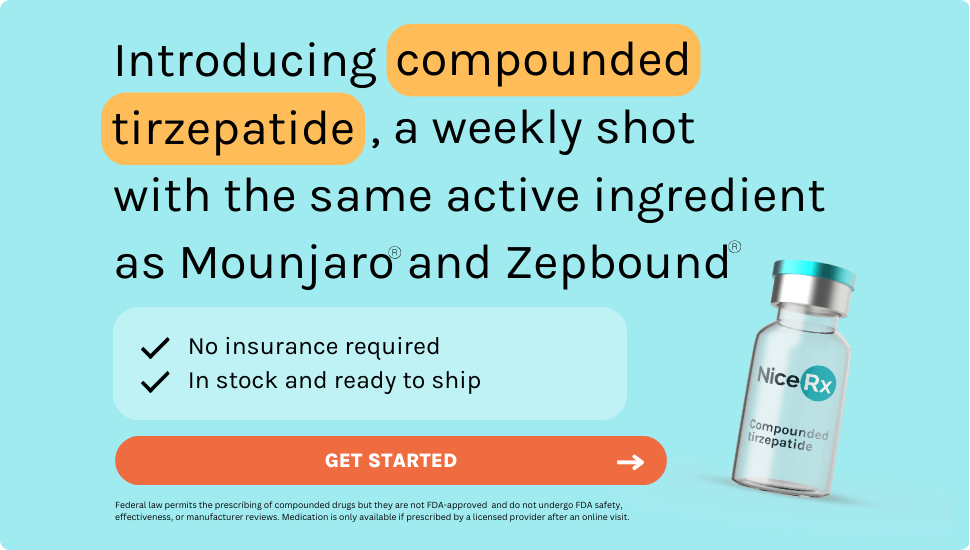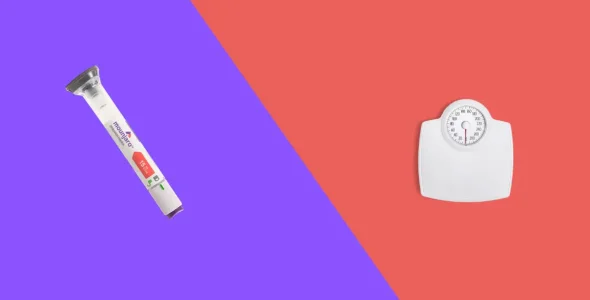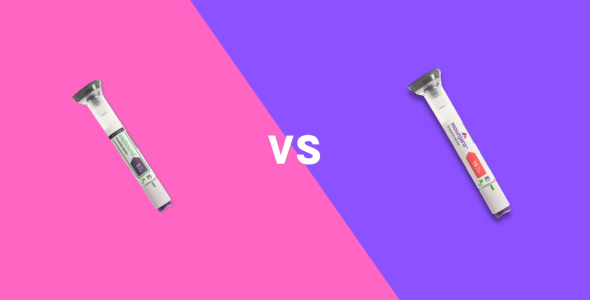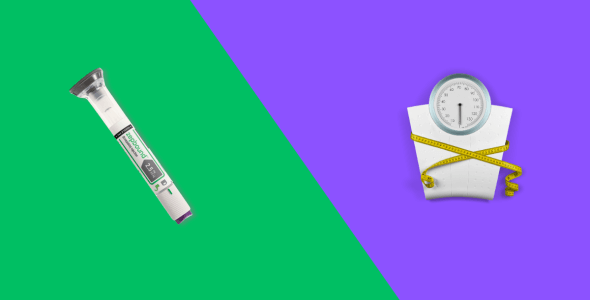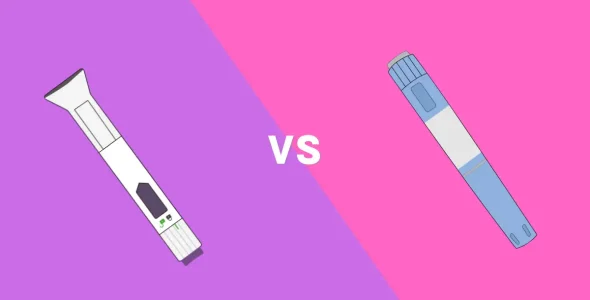How much is Mounjaro without insurance?
Key highlights
- Mounjaro (tirzepatide) is a once-weekly injectable medication for type 2 diabetes. While the manufacturer’s list price is $1,069.08 per month, you can expect to pay in the range of $1,000-$1,200 per month depending on the pharmacy you buy from.
- Mounjaro is commonly prescribed off-label for weight loss but insurance plans typically don’t cover medications that are prescribed for an indication that the medication is not FDA-approved for.
- If you’re using the medication for weight loss, the manufacturer, Eli Lilly, has another medication approved for chronic weight management, Zepbound, which contains the same active ingredient, tirzepatide.
- If you have private or commercial insurance, you may be eligible to pay as low as $25 for a 1, 2 or 3-month supply of Mounjaro or Zepbound.
Mounjaro (tirzepatide) is a GLP-1/GIP prescription injectable medication that was FDA-approved in 2022 for controlling blood sugar levels in adults with type 2 diabetes, in combination with diet and exercise.
Recently, the FDA (U.S. Food and Drug Administration) approved Zepbound, which has the same active ingredient as Mounjaro, tirzepatide, for chronic weight management in people with obesity or overweight and at least one other weight-related condition. Clinical trials conducted by Eli Lilly have shown promising weight loss results for people taking tirzepatide.
If you’ve been prescribed Mounjaro and have insurance, check your insurance plan’s formulary or contact your insurance company to find out if it’s covered. Without insurance, Mounjaro costs about $1,000 per month. The price can vary depending on the pharmacy and your eligibility for the manufacturer’s savings card program. Read on to learn more about Mounjaro cost without insurance and learn how to save on this medication with or without insurance.
How much does Mounjaro cost without insurance?
The list price of Mounjaro, according to the manufacturer’s website, is $1,069 for a one-month supply which includes 4 pre-filled injectable pens.
If you have prescription insurance coverage, you won’t typically pay the full list price for Mounjaro, and the price you pay out-of-pocket will depend on your insurance plan’s coverage, copay, and deductibles. You may be eligible for additional savings if you meet certain requirements for the Mounjaro Savings Card which lowers the cost of Mounjaro to as low as $25 for a 1, 2, or 3-month supply.
Without insurance, the average retail price for Mounjaro ranges from $1,000 to $1,200, depending on several factors, including:
- Your location: The prices of medications vary by location. A report by GoodRx shows that the most expensive cities for prescription medications are Little Rock-Pine Bluff, Arkansas, New Orleans, Louisiana, New York, New York, Milwaukee, Wisconsin, and Lexington, Kentucky, with prices 15-20% above the national average.
- The pharmacy you use: The prices charged by pharmacies can vary, even in the same neighbourhoods. Compare prices at multiple pharmacies to find the best deal.
- The reason you were prescribed Mounjaro: If you were prescribed Mounjaro for its FDA-approved indication, type 2 diabetes, your insurance may cover some or all of the cost. If you were prescribed Mounjaro off-label for weight loss, it’s unlikely your insurance company will cover it and you can check if Zepbound or any other weight loss drugs such as Wegovy are covered by your insurance plan.
- Your eligibility for the manufacturer’s savings card: If you are eligible for the manufacturer’s savings card program, you can potentially pay as low as $25 for a 1, 2, or 3-month supply of Mounjaro.
- Prescription discount cards: If you are paying out-of-pocket for Mounjaro without insurance, you may be able to save money by using prescription drug discount cards offered by companies like GoodRx and SingleCare.
If you don’t have insurance, ask your healthcare provider about alternative prescription medications for diabetes including GLP-1 drugs and non-GLP-1 drugs. There are also lower price generic medications for diabetes such as metformin. However, the effectiveness and side effects of each drug may differ, and most non-GLP-1 drugs don’t provide as substantial weight loss benefits as GLP-1 drugs.
Is there a generic Mounjaro?
Unfortunately, no. As there’s currently no generic or biosimilar version of Mounjaro in the United States, the cost of Mounjaro is significant, especially for those without insurance or eligibility for the manufacturer’s savings card.
The patent for Mounjaro (tirzepatide) is expected to expire in 2036. Unfortunately, there will be no generic version available in the United States until the patent expires.
You may also have noticed that there are compounded versions of tirzepatide being marketed online. Compounded drugs do not have the same FDA regulations as generic drugs. Speak to a pharmacist or healthcare professional to determine if a compounded version of tirzepatide is right for you.
Why is Mounjaro so expensive?
Mounjaro, like other brand-name drugs that are still under patent protection, has no competition from generic companies as the brand-name manufacturer has a monopoly on sales until the patent expires. The prices of brand-name drugs in the United States are typically the highest in the world and on average, 4.22 times higher than other countries.
Once the patent expires, generic companies will start selling an equally as effective, FDA-approved generic version of Mounjaro.
How to save on Mounjaro
There are several ways for you to save on your out-of-pocket costs, with or without insurance coverage. The maximum savings are available through the Mounjaro Savings Card, if you’re eligible and meet the requirements.
Mounjaro Savings Card
If you have private or commercial insurance and don’t have any government insurance (e.g. Medicare, Medicaid, TRICARE, VA, or any other government-sponsored program), you may be eligible to pay as low as $25 for a one-month (28 days – 4 pens), two-month (56 days – 8 pens), or three-month (84 days – 12 pens) supply of Mounjaro with the Mounjaro Savings Card.
You must be a legal resident of the United States or Puerto Rico who is at least 18 years of age or older and have been prescribed Mounjaro for type 2 diabetes. If you were prescribed this medication for weight loss, you won’t be eligible for the savings card program.
Savings are limited by the manufacturer to $150 for a 1-month prescription, $300 for a 2-month prescription, or $450 for a 3-month prescription, and maximum annual savings of up to $1,950 per calendar year.
The savings card can be used for a maximum of up to 13 times per calendar year.
Mounjaro coupons and prescription discount cards
Some pharmacies and retailers may offer coupons for Mounjaro that don’t need insurance.
Several companies offer free prescription discount cards for Mounjaro which can be used at a local pharmacy, including:
You should shop around at multiple pharmacies for the lowest possible price.
Compounded tirzepatide
Given the increasing popularity of Mounjaro and Zepbound, tirzepatide is listed on the FDA Drug Shortages website and compounding pharmacies are permitted to supply compounded tirzepatide, which contains the same active ingredient as the brand name drugs.
You can purchase compounded tirzepatide through the NiceRx Weight Loss Program, if approved for a prescription after completing a telehealth visit with a licensed healthcare provider.
Ask your healthcare provider about lower-cost diabetes medications
Speak with your provider about potentially switching you to a lower-cost alternative medication for diabetes, including other GLP-1 receptor agonists that are similar to Mounjaro.
Enroll in Medicaid
If you are eligible for Medicaid, you can potentially obtain coverage if your state’s Medicaid plan covers Mounjaro. Check with your Medicaid state agency to verify coverage details and eligibility requirements. You can enroll online on the Medicaid website.
Is Mounjaro covered by insurance?
Yes, if you have insurance coverage and were prescribed Mounjaro for type 2 diabetes, it’s likely your insurance plan will cover it. Check with your insurance provider to verify that Mounjaro is covered and ask for coverage details including the associated copay, deductible, and if prior authorization is required. Your insurance company may have an online portal where you can search for covered medications, or you can contact them directly by calling the phone number on the back of your insurance card.
As Mounjaro is not FDA-approved for weight loss, it’s unlikely that your insurance company will approve coverage if the medication was prescribed “off-label” for weight loss. Check the drug formulary or ask your insurance company if they cover any other weight loss drugs including Zepbound (tirzepatide), another medication with the same active ingredient, tirzepatide, manufactured by the same company, Eli Lilly. Zepbound was approved by the FDA in 2023 for chronic weight management.
Does Medicaid cover Mounjaro?
Medicaid coverage varies by state so you’ll need to check with your Medicaid state agency to verify if Mounjaro is covered. Each state has its own rules concerning prior authorizations and step therapy. As of July 1, 2023, 16 states cover weight loss medications (12 of which cover Saxenda, Wegovy and Zepbound).
Does Medicare cover Mounjaro?
Many Medicare plans will cover Mounjaro if it was prescribed for type 2 diabetes, and not for weight loss. Your out-of-pocket costs will depend on your insurance plan’s copay and whether you have met the deductible requirement.
For people who are enrolled in a Medicare Part D prescription drug plan, coverage for Mounjaro will depend on whether it’s listed in the drug formulary (list of covered drugs). If it’s listed in the drug formulary, you may still be required to submit a prior authorization or complete step therapy (trying and failing on a lower-cost alternative medication) before coverage is approved, with the assistance of your healthcare provider.
If Mounjaro is not listed in the formulary, you can ask your provider for assistance in submitting a formulary exception request, and your provider will need to provide evidence to justify that Mounjaro is medically necessary for your health condition.
Currently, Medicare does not cover any weight loss drugs so if you were prescribed Mounjaro or Zepbound for weight loss, it’s unlikely you’ll receive coverage due to the 2003 Medicare Modernization Act (MMA) which is an act that classified weight loss medications as lifestyle medications instead of medically necessary drugs.
How much is Mounjaro with insurance coverage?
The cost of Mounjaro with insurance varies depending on your insurance plan and coverage details. If your insurance plan covers Mounjaro and you have type 2 diabetes, you may have a low copay and your out-of-pocket expenses can be significantly reduced to as low as $25 per month by using the Zepbound Savings Card, if you are eligible and meet the savings program’s requirements.
To find out how much you will need to pay, review your drug formulary or contact your insurance company directly to find out more details about Mounjaro’s coverage under your insurance plan.
How to get Mounjaro covered by insurance
It’s likely that your insurance provider will only cover Mounjaro if you have type 2 diabetes, and not for weight loss. You can try the following to get Mounjaro covered by your insurance plan:
- Speak with your healthcare provider: Before applying for insurance coverage, speak with your healthcare professional to find out if Mounjaro is medically appropriate for your condition and get a Mounjaro prescription.
- Review your insurance plan’s drug formulary: You can review the drug formulary in your insurance plan documents or the insurance provider’s website, or by contacting your health insurance company. Ask them if they cover Mounjaro, what are your out-of-pocket costs including the associated copay and if prior authorization or step therapy is required for coverage to be approved. If Mounjaro is not listed as a covered medication, ask your insurance provider for the necessary steps to complete a “formulary exception request” which typically involves your healthcare provider submitting evidence to justify that the medication is medically necessary for your condition
- Prior authorization, if required: If your insurance company requires prior authorization, your healthcare professional may need to submit clinical evidence confirming that you have type 2 diabetes along with other details that may be required by your plan.
- If denied, request an appeal: If your insurance company denies your initial request for coverage, you are entitled to submit an appeal with the help of your healthcare professional. Eli Lilly provides a sample letter of medical necessity that your healthcare provider can use to request coverage.
Is it possible to get Mounjaro for free?
You can get Mounjaro for free if your insurance provider doesn’t have a copay or deductible.
However, it’s unlikely that you’ll be able to get Mounjaro for free as it’s typically listed as a non-preferred drug, meaning it’s more likely to have a copay. As well, there is currently no patient assistance program available for Mounjaro.
Speak with your insurance provider to find out more coverage details including copays and deductibles for this medication.
Your healthcare provider may be able to provide you with a free sample when you start taking the medication.
Mounjaro alternatives
There are several alternatives to Mounjaro including GLP-1 (glucagon-like peptide-1) receptor agonists and non-GLP-1 drugs. You can discuss these alternatives with your healthcare provider to determine if any of them are medically appropriate for you. If Mounjaro isn’t covered by your insurance plan, you can also check with your insurance provider if any of these medications are covered under your plan.
GLP-1 alternatives
- Ozempic (semaglutide):
- Wegovy (semaglutide)
- Rybelsus (semaglutide)
- Zepbound (tirzepatide)
- Saxenda (liraglutide)
- Victoza (liraglutide)
- Trulicity (dulaglutide)
- Bydureon (exenatide)
Non-GLP-1 alternatives
There are several non-GLP-1 medications that are prescribed for diabetes and off-label for weight loss.
Non-GLP-1 diabetes medications
- Glucophage (metformin)
- Invokana (canagliflozin)
- Farxiga (dapagliflozin)
- Jardiance (empagliflozin)
Non-GLP-1 weight loss medications
- Contrave (bupropion/naltrexone)
- Alli and Xenical (orlistat)
- Qsymia (phentermine/topiramate)
- Topamax (topiramate)
Bottom line
Mounjaro is a costly drug without insurance and prescription drug coverage. Most insurance companies won’t cover Mounjaro unless you have type 2 diabetes. Without insurance coverage, Mounjaro can cost anywhere from $1,000 to $1,200 per month, depending on which pharmacy you purchase from, and your eligibility for the manufacturer savings program. If you have commercial insurance, you may be eligible to pay as low as $25 per month with the Mounjaro Savings Card.
If you are taking the medication for weight loss, you can check with your insurance plan if they cover Zepbound, which is FDA-approved for chronic weight management. If you have commercial insurance, you may be eligible to pay as low as $25 per month with the Zepbound Savings Card.


